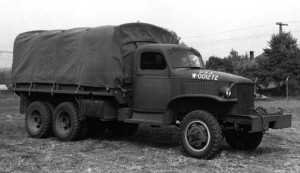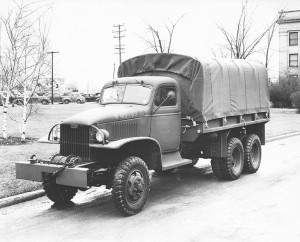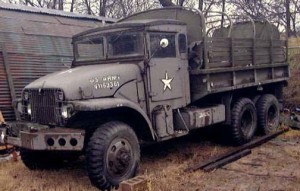GMC 6×6 Cargo Army Truck in WW2
When the US Army Quartermaster Corps began developing its so-called ‘Standard Fleet’ around 1928, the 60 or so vehicles included were broken into five groups numbered I to 5, each roughly corresponding to a weight class.
Among the new designs in group I, the lightest weight class, there were two 2.5 -ton 6×6 vehicles. When they were subsequently rolled out of the shops of the Hoiabird Quartermaster’s Depot in 1932, one, W3228, was powered by a Duesenberg J engine, while the other, W3229, was powered by a Lycoming. In time, a Franklin air-cooled V12 was also trialled in one of the vehicles.
It is worth noting that during this time, a certain AW Herrington was employed by the Motor Transport Division of the Quartermaster Corps. While the Standard Fleet did not enter mass production, the vehicles created were instrumental in defining future generations of US Army tactical vehicles. The Standard Fleet had been created with the purpose of crafting vehicles built to wholly military specifications using standardised components, as opposed to the previous process of buying commercial vehicles from a variety of manufacturers – vehicles that might have closely fitted military needs, but were rarely exactly what the US Army wanted. Ultimately however, Congress and the Comptroller General of the United States decreed that the Army could not produce its own vehicles as it had with the Standard Fleet, but rather had to rely on private enterprise for its future needs.
 Although those with dual rear wheels faired better, the off-road shortcomings of two-axle vehicles, even 4x4s, were obvious. Accordingly, consideration was given to 6×6 trucks, and in 1933 the Army procured a commercial 2.5-ton 6×6. Designated the TL29-6, this truck was manufactured by the Indianapolis-based Marmon-Herrington Company, which had AW Herrington, no longer in the service of the Army, as one of its principals.
Although those with dual rear wheels faired better, the off-road shortcomings of two-axle vehicles, even 4x4s, were obvious. Accordingly, consideration was given to 6×6 trucks, and in 1933 the Army procured a commercial 2.5-ton 6×6. Designated the TL29-6, this truck was manufactured by the Indianapolis-based Marmon-Herrington Company, which had AW Herrington, no longer in the service of the Army, as one of its principals.
The TL29-6 was not without competition, as Corbitt offered the Army its 168-FD8.
While neither design was an outright failure, neither offered the Army what it wanted at the price it wanted to pay. At this point in time, powered front axles were still in their infancy, and vehicles so equipped were limited-production, expensive, specialist machines. However, the concept had piqued the interest of the GMC Division of automotive titan General Motors.
GMC had its origins in the Rapid Motor Vehicle Company and the Reliance Motor Company, both Detroit-based independent truck manufacturers. W C Durant, who began assembling the corporate behemoth that would become General Motors, purchased Reliance in 1908, and followed that with the purchase of Rapid in 1909. Reliance and Rapid combined to form the General Motors Truck Company, and the GMC logo first appeared in 1911.
In Chicago, an empire was also being built by John D Hertz – later of rental car fame – who owned Yellow Cab. In November 1922 he purchased the Lake Shore Motor Bus Company, which included the American Motor Bus Manufacturing Company. The initial function of the firm was to provide buses for the Chicago Motor Bus Company, also controlled by Hertz, but it was soon selling motor coaches to other operators.
On 17 April 1923, the American Motor Bus Manufacturing Company was sold to the Yellow Cab Manufacturing Company, which promptly reorganised as the Yellow Coach Manufacturing Company.
 The business prospered, with well over 2000 units being delivered between August 1923 and July 1925, about half going to Hertz-controlled firms. The company’s success was noted by Alfred P Sloan, chairman of General Motors, and, on 8 July 1925, a merger of General Motors with Yellow Coach Manufacturing was announced. General Motors would get 60% of the new holding company, Yellow Truck and Coach Company, in exchange for the assets of General Motors Truck Company (GMC) and the obscure GM subsidiary of Northway Motor and Manufacturing Company.
The business prospered, with well over 2000 units being delivered between August 1923 and July 1925, about half going to Hertz-controlled firms. The company’s success was noted by Alfred P Sloan, chairman of General Motors, and, on 8 July 1925, a merger of General Motors with Yellow Coach Manufacturing was announced. General Motors would get 60% of the new holding company, Yellow Truck and Coach Company, in exchange for the assets of General Motors Truck Company (GMC) and the obscure GM subsidiary of Northway Motor and Manufacturing Company.
On 26 August 1925, the deal was consummated and, in March 1927, the new firm acquired a 160-acre tract of land near Pontiac, Michigan, for the construction of a new assembly plant.
Trucks began leaving the assembly line on 5 January 1928. With 26 acres under cover, it was at the time the world’s largest truck plant.
It was from this formidable position that General Motors entered into the US Army 6×6 fray in response to a 1937 invitation to bid. Its purpose-built model 4929 was a stylish 1.5-ton truck featuring an Oldsmobile 230 engine mated to a Chevrolet four-speed transmission, powering Timken axles through a Wisconsin T32 transfer case. The front-end sheet metal was Chevrolet pattern, and the truck chassis was a modified Yellow commercial unit. Utilising such readily available components both lowered unit cost and speeded up production. In total, 229 were built against contract 398-QM-6270 valued at $539,534, and the last was delivered on the final day of May 1938.
Also in 1938, GMC’s efforts to develop an engine for use in commercial vehicles bore fruit when its 4067cc six-cylinder design emerged. This engine would play an important role in GMC’s future military contracts, as would the model 4929 truck. However, the engine’s first military application was to power the 21/2-ton 6×6 model 4937, only 11 of which were built – 10 for the US Marine Corps and one for export. With the exception of the engine, the rest of the powertrain was shared with the model 4929.
In 1939 the US Army issued solicitation to bid number 398-40-2601939 and the die was cast for the truck that would ultimately become the ubiquitous CCKW. The specification called for a cross-country payload of 5000 lb (2273kg), required a top speed of 45mph (72km/h) and demanded the ability to climb a 1:30 gradient in direct drive.
 Studebaker and Mack responded to the solicitation, as did Yellow Truck and Coach, the latter designating its new design the model ACKWX-353 (A = 1939 model year; C = conventional cab; K = selective front-wheel drive; W = driven tandem axles; X = non-standard (Timken) driveline; 353 = chassis code). Bids were opened on 18 May 1939, and the contract awarded to GM on 15 June of the same year. The company delivered 32 of the new trucks on 4 January 1940, with one more four days later, all powered by the same 4067cc engine as the model 4929 and 4937. Thereafter, the ACKWX-353 was powered by a 4198cc version of the same engine.
Studebaker and Mack responded to the solicitation, as did Yellow Truck and Coach, the latter designating its new design the model ACKWX-353 (A = 1939 model year; C = conventional cab; K = selective front-wheel drive; W = driven tandem axles; X = non-standard (Timken) driveline; 353 = chassis code). Bids were opened on 18 May 1939, and the contract awarded to GM on 15 June of the same year. The company delivered 32 of the new trucks on 4 January 1940, with one more four days later, all powered by the same 4067cc engine as the model 4929 and 4937. Thereafter, the ACKWX-353 was powered by a 4198cc version of the same engine.
While the GMC parts book indicates that the serial number range for these vehicles was ACKWX353-3604 through ACKWX353-6070, totaling 2466 vehicles, GM’s records show that 2469 were built under contract for the US government (this includes the 33 trucks powered by the 4067cc engine). Fifty of the trucks, all powered by the larger capacity engine, were equipped with winches. A further single unit was built for GM’s demonstration purposes, and a single right-hand drive version with the 4067cc engine was built for the French, with another possibly for Switzerland. By far the largest overseas order was for 1000 trucks with the 4198cc engine, which went to Great Britain in 1941 on sales order 10000-999.
While it has been reported that some overseas customers felt that the 4198cc powerplant was too much engine for the truck, the feeling Stateside was that the vehicle needed more reserve power. GM therefore responded by beefing up the engine to a more formidable 4428cc. Not content to merely increase the stroke, GM also improved bearings and cylinder head cooling at the same time. Incredibly, the first engine was run less than a month after the concept was floated on 18 July 1940, and the foundation was laid upon which to build the next generation of military 6x6s, the CCKWX.
